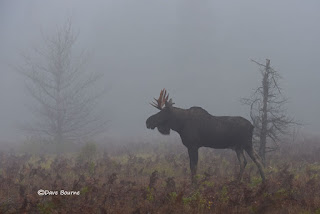We have encountered many moose in our travels all over North America. It was not uncommon while on canoe trips with the kids when they were young to encounter around twenty moose every trip. We've also had some close encounters with moose, whether almost running into them while paddling down small streams in Algonquin, or actually being charged by a female protecting her newborn during a totally surprise encounter on a trail in Alaska. Not to mention having moose grazing all over the road in the early morning fog in Newfoundland on our way to see ice bergs at Goose Cove.
These are a couple of the cooler more recent images I have of moose. All taken in Algonquin Provincial Park.
Moose are the largest members of the deer family, standing six feet tall from hoof to shoulder, and weighing in at more than 1,000 pounds. Each of their light to dark brown hairs is hollow, and the air trapped inside provides insulation. A flap of skin called a dewlap hangs from the throat. Males are distinguished from females by their antlers, which grow up to six feet across.
Moose suffer from a predator of another sort, parasitic brain worms. White-tailed deer are carriers of the parasite, but it has no effect on them. When deer defecate, the brain worms are transferred from their waste to land snails. When moose unknowingly eat the snails while foraging for food, they ingest the parasite.
Male moose, called bulls, begin to grow antlers in springtime to prepare for the autumn mating season. Large, mature bulls with well-developed antlers usually get to mate with the female moose, called cows.





No comments:
Post a Comment